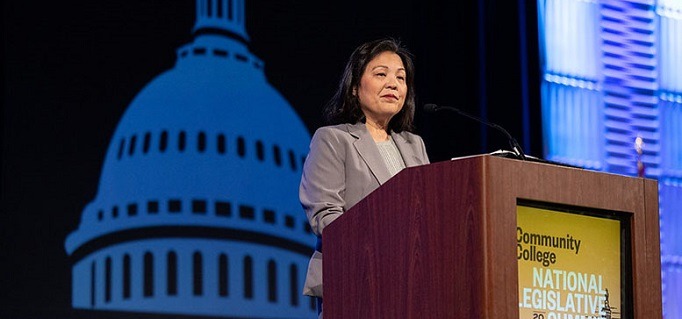A look at how SCCT grants are working
By Matthew Dembicki
February 14, 2024
Acting Labor Secretary Julie Su on Feb. 6 provided insight into some common themes emerging among two-year colleges that have received funding through the U.S. Labor Department’s Strengthening Community Colleges Training (SCCT) Grants Program.
Speaking at the Community College National Legislative Summit (NLS) in Washington, D.C., Su said she sees three threads among grantees over the first three years of the SCCT Grants Program, which aims to build the capacity of community colleges to meet labor market demand for a skilled workforce. (NLS is annually held by the Association of Community College Trustees in partnership with the American Association of Community Colleges.)
The first is the importance of partnerships. These include employers, unions, state and local workforce boards, K-12 and nonprofits, among others, that work together on efforts such as work-based learning, credential matches and serving on advisory committees, Su said.
The second is the use of accelerated and flexible credentials. Su said one of the purposes of the grants is to create more flexibility to allow colleges and partners to be more nimble.
The third is improving connections across the education systems, especially in outreach to K-12 and other systems to inform students and families of career pathways and related opportunities.
In the SCCT Program’s inaugural year in 2021, DOL awarded $40 million in grants to 11 community colleges, including seven consortium grants and four single institution grants. In 2022, the department awarded $45 million to 13 community colleges, including seven consortium grants and six single institution grants. Last year, DOL awarded $50 million in SCCT grants to 15 community colleges, including eight consortium grants and seven single institution grants.
DOL expects to announce soon the colleges that will receive funding through the fourth round of SCCT grants.
Grantee overviews for the first three rounds of SCCT grants
Some examples
Su highlighted some of the projects of the SCCT grantees, noting in particular their work on inclusion. Savannah Technical College in Georgia, for example, is using its grant to build a consortium with other two-year colleges and partners to engage with employers and others in creating a system of awarding micro-credentials in specific occupational clusters. The goal is to provide training so participants can get entry-level jobs quickly and use those as a first step along a career, Su said.
Meanwhile, Los Angeles Mission College is using its SCCT grant to increase the number of Latino workers in good-paying jobs as licensed vocational nurses and EKG technicians, Su said. To do this, the college is working with unions.
Su also highlighted inclusion and diversity efforts among recipients of grants in other DOL programs. Lawson State Community College in Alabama will provide a pre-apprenticeship program that is geared toward increasing the number of Black women in advanced manufacturing programs.
Continue the support
Su said she recently spoke with a student at Gateway Community College in Connecticut who is studying biomedical engineering. She is the only woman in its courses.
“That makes her feel like she has to be 110% right before she opens her mouth,” Su said.
Su relayed that the student encourages community college leaders to continue pushing the importance of diversity on campuses and even before students get on campuses.
“Young people feel the pushback on this,” she said.
Su added that diversity is key to attracting previously excluded populations and helping address the critical workforce shortage that many employers face.
“We cannot leave diverse talent untapped,” she said.
This article originally appeared in CC Daily.



